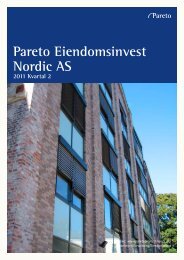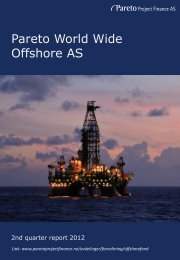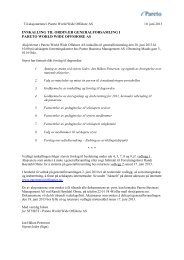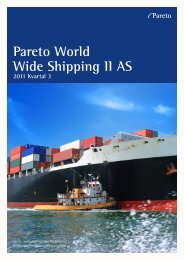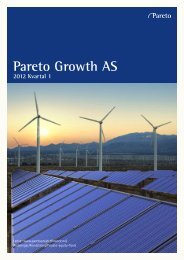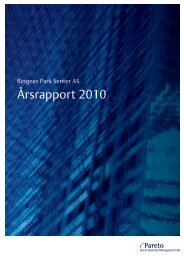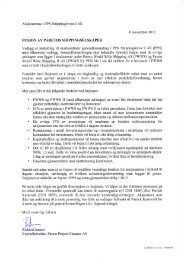Pareto World Wide Offshore AS - Pareto Project Finance
Pareto World Wide Offshore AS - Pareto Project Finance
Pareto World Wide Offshore AS - Pareto Project Finance
You also want an ePaper? Increase the reach of your titles
YUMPU automatically turns print PDFs into web optimized ePapers that Google loves.
<strong>Pareto</strong> <strong>World</strong> <strong>Wide</strong><strong>Offshore</strong> <strong>AS</strong>3rd quarter report 2012Link: www.paretoprojectfinance.no/avdelinger/forvaltning/offshorefond
Executive SummaryNAV NOK 118/share(as of 30.06.2012)The offshore oil services markets continue to tighten and the outlook for the oil industry’s upstream spending in thecoming years is very encouraging. Owners of modern high quality assets look well placed to reap solid returns, bothin the form of increasing earnings and appreciating values. While the current weak financial markets depress assetvalues a bit, the bonus is that it will also restrict speculative newbuilding, thus improving future utilisation levels.Market Development<strong>Offshore</strong> oil service activity levels have risen significantly inthe past year. As a result, utilization levels have improved,leading to significantly improved rate levels. As evidencedby the mushrooming order backlogs amongst oil servicecompanies, the volume of work in the coming years seemsto be very solid. This is also leading to more long termcontract opportunities, which is a bonus with regards tofinancing.On the other hand, both stock markets and oil prices havebeen volatile. While the current levels reflect a certaindegree of optimism, things will continue to be sensitive todevelopments in the European debt crisis as well aseconomic data coming out of China and a solution to theIranian stand-off.Bank financing has become much more restricted and thelack of funding is restricting asset transactions anddepressing asset values. On the positive side, it also limitsthe scope for speculative newbuilding, which ultimately willbe positive for the future asset utilization levels.In the coming years, we expect oil industry spending growthto stay in excess of 10% per annum. This will be primarilydriven by efforts to stem the declining production fromexisting reserves. Demand growth for oil & gas will be asignificantly less important driver.New reserves are more costly and difficult to develop,requiring more oil service input, which takes more time toprovide. As a result, the main problem for the oil industry isactually turning new reserves into production, as evidencedby the disappointing production growth figures seen amongoil companies and main producing regions alike. The oilindustry is facing an uphill battle and will be forced tocontinue to hike spending to keep pace. And increasingcosts will raise the price of the marginal barrel, providingsupport for global oil prices.PortfolioFollowing a successful turnaround of its portfolio during2011, PWWO retains a high contract coverage, whichcurrently stands at 92% with an average contract length of4.6 years. The bulk of the backlog is against solid andprofitable counterparts.The portfolio is focused on modern assets and is well spreadacross several market segments and geographic regions.The high contract coverage is expected to result in a solidincrease in incoming cash flow, which in turn will take downasset exposure and pave the way for increasing pay-outs toshareholders.There has been one significant negative development,however. Songa <strong>Offshore</strong> has signed a Heads of Agreementto sell the Sonca Eclipse to Seadrill. This would in principletrigger a bonus payment to PWWO on top of the proceedsthat were received upon the sale of PWWO’s 13% stake toSonga in Q2’11. This bonus payment is dependent on theprice of the rig, as well as the level of net interest bearingdebt in the project. No price has been disclosed, butspeculation is that it is well below the price Songa paidPWWO last year. Moreover, the significant operationalheadwinds have resulted in a substantial cash drain in theproject since the rig was delivered, meaning that the level ofdebt attached the rig is way above plan. Therefore, a bonuspayment appears very unlikely. This will have a negativeimpact on PWWO NAV of around NOK 9 per share, but willhave no effect on the existing cash reserves in PWWO.In agreeing to the bonus scheme, PWWO placed a bet thatultra deepwater markets would improve going forward. Thiswas spot on, but we were stuck on the wrong horse. Thegood thing is that we got out before things really turnedbad.The way forwardPWWO has paid NOK 22 per share to its shareholders duringthe past two years. In general, the contract backlog willsupport roughly a similar level going forward, with assetsales proceeds providing an upside potential. On the otherhand, the loss of the potential proceeds from the SongaEclipse bonus payment will have a negative effect on thedividend capacity.The board strives to maximize values for its shareholdersand believes that project realizations should be done later,rather than sooner. This is to reap rising asset values, aswell as to exploit the rapid deleveraging in the underlyingprojects. With reference to our discussion about the marketdevelopment on this page, it is definitely not a seller’smarket out there and asset owners will be well advised tohave patience to maximize exit values.The board is conscious that the current financial distressseen in many markets will provide interesting investmentopportunities, some of which we have already looked at. Adiscounted investment in a good market could provide extrareturn potential for shareholders.The strategy towards 2014 will therefore be to build on thecurrent, solid portfolio, with a view to make a full exit atthat time. This is considered a better alternative than aforced run-off in an early market recovery phase. However,the current state of the financial markets indicate that thismay take longer than earlier anticipated.
Portfolio NewsPWWO is invested in a broad range of offshore projects, which implies a significant diversificationacross different asset types and market segments. This section provides an update on the quarter’smost important news flow related to the underlying investments.Songa EclipsePWWO sold its 13% stake in the rig to Songa <strong>Offshore</strong>in Q2’11 at an implicit rig value of around USD 660mincluding capitalized expenses. Songa has now signed aHeads of Agreement to sell the rig to Seadrill at pricewhich is rumoured to be between USD 600m-650m. Inconnection with the sale last year, PWWO secured apotential bonus payment through February 2013dependent on the development of the rig’s value andthe cash flow in the project up that time. Theoperational problems on the rig since delivery haveresulted in a substantial negative cash flow instead.With the rig value now seemingly set below the initialtransaction price, it seems highly unlikely that therewill be any bonus payment.While this looks to have a negative impact on PWWONAV of around NOK 9 per share, there will be noimpact on current cash holdings. In agreeing to thebonus payment, we placed a bet that global UDWmarkets would improve significantly. That was a correctassumption, but we were simply stuck on the back ofthe wrong horse. While this is unfortunate for ourshareholders, we at least managed to get out beforethings really turned bad in Songa. Last year, werealised NOK 96m from selling to Songa (NOK 22 pershare). Had we retained our stake, the sale to Seadrillwould have given us something close to zero (!).built vessels straight from shipyard to the North Seahas not gone undisturbed, but as they’ve now beenthrough the major teething troubles, we believe thevessels will be able to compete well with similarNorwegian built vessels at significantly higher buildingcost.Neptune <strong>Offshore</strong> <strong>AS</strong>In addition to Neptune <strong>Offshore</strong> <strong>AS</strong>’ 29% share inNeptune Subsea IS, it also holds a 50% share inNeptune Seismic DIS. Neptune Seismic has entered anew 12+12+6+6 months time charter with CGG Veritasat slightly higher rates. This is a very attractivecontract which offer great return to the equity. On thenegative side, the docking of the vessel in Q3’12 endedup significantly higher than budget - thus cancellingnext quarter’s planned dividend.Parbarge ISThe charterer recently declared the option to extendthe contract length by 5 years, meaning that the twobarges will be employed until July 2023. This indicatesthat the barges are working satisfactory and that thedayrates in West Africa are strong enough to provide aprofitable and healthy business for the charterer.Another positive effect from the extension is that theassets’ residual risk is significantly reduced.BassDrill AlphaThe tender rig is currently employed by Total in Congoon a contract that will run towards the end of 2013.The rig has received a letter of award from the sameclient for an extension of up to 3 years at a dayratewhich is up more than 15% from current levels. Theoperations have improved significantly in the past yearwith lower costs and increased commercial uptime. Therig is fully financed with a rapid deleveraging that willleave the owners with an attractive position when itcomes to an exit or re-financing in the coming years.Neptune Subsea ISBoth vessels are chartered out on 5-year bareboatcontracts to Reef Subsea who are trading them in theNorth Sea. Subcontractors such as Statoil and Talismanare pleased with how the vessels are operating andReef express confidence that the vessels will have along and solid future in both the North Sea and otherharsh environments. The process of bringing Chinese
Portfolio News (continued)Asian <strong>Offshore</strong> III ISA more extensive comment on this project can befound on page 5 under “This quarters investmentreview”. We are, however, pleased to report that wehave created a new operational set-up for this projecttogether with two partners with a similar fleet ofvessels. We now have a fleet of 15 5,000-6,000 BHPAHTS operating in a pool in Asia and West Africa. Thepool is operated by a jointly owned company, RK<strong>Offshore</strong> International. This company is alsoresponsible for the technical operation of the ships, aswell as for another six offshore support vessels. Theemployment and earnings of the vessels is generallyimproving with an increasing number of tenders in themarket. We have also negotiated terms with our banksthat will help safeguard underlying vessels.Master and Commander ISPWWO purchased 5% in this project through thesecond-hand market. M&C was established in 2006 andconsists of two seismic vessels on bareboat contracts.The largest and most valuable vessel is on a bareboatcontract until 2019 which is guaranteed by CGG Veritas– the world’s biggest listed seismic operator. Thesmaller vessel is on a bareboat contract until 2015,which is guaranteed by a smaller operator namedReflect Geophysical. The fund manager is particularlyoptimistic about this investment, because the projectyields a solid cash flow and the residual value risk ishighly limited. Furthermore, the seismic market isparticularly attractive at the moment, with a healthysupply/demand balance and decent dayrates for bothnew and old vessels.New investmentsThe Board and the manager are actively seeking toexploit particularly attractive investment opportunitiesarising from financially distressed owners and tuningthe portfolio towards a planned liquidation or sale in2014. PWWO therefore invested NOK 8m in Master andCommander during Q3’12. In addition, NOK 2m waspaid in to Asian <strong>Offshore</strong> III to boost working capital inthis project.<strong>Project</strong> salesThere have been no straight project sales during Q3’12.Payments from projectsDuring Q3’12, PWWO received a final payment of NOK0.4m in relation to the previous sale of Middle EastJackup Ltd. and NOK 7.6m as partly repayment of theconvertible bond in Neptune <strong>Offshore</strong>. The rest of thebond was converted into equity at NAV.
This Quarter’s Investment Review:Asian <strong>Offshore</strong> IIIThis project was started in 2007 to construct a total of six 5,000 BHP AHTS, which were bareboat chartered to RK<strong>Offshore</strong>, which had back-to-back contracts with Sanko Steamship Ltd in Japan. The vessels were delivered in 2009-10. As Sanko filed for bankruptcy protection in July this year, the contracts were cancelled and the project now hasdirect market exposure, instead of a fixed bareboat charter income. As a result, a restructuring was needed toprovide the best possible platform for continued employment of the ships.Up until this year, this project developed according toplan, along with its sister project Asian <strong>Offshore</strong> I(virtually identical set up). The vessels were deliveredlargely on time and the charterer paid the hire punctuallyfrom delivery, sheltering the projects from the plunge inthe underlying charter markets. As the broker values ofthe vessels held up well despite the market volatility, theprojected returns on the project were solid, around 15%IRR.However, Sanko finally folded this year as weak shippingmarkets, singificant charter obligations and a largenewbuilding programme took its toll. As a result, AO IIIcancelled its contracts through RK <strong>Offshore</strong> in July thisyear and were left with 6 vessels with direct exposure tothe underlying markets.Since then, AO III has teamed up with its sister projectAO I as well as Tufton Oceanic, a fund with a nearidentical set-up through RK <strong>Offshore</strong> to Sanko, toestablish a new organization to cater for the commercialand technical operation of the vessels.This was established with effect from 1 October underthe name RK <strong>Offshore</strong> International. RKOI will operateone pool for a total of fifteen 5,000-6,000 BHP AHTS(including 5 from Tufton), as well as a pool for four10,000 BHP AHTS (owned by Tufton). A subsidiary ofRKOI will also operate the vessels technically, with theaddition of up to five other offshore support vessels.RKOI is jointly owned by AO I, AO III, Tufton and themanagement. The vessels continue to be owned by AO I,AO III and Tufton.We expect that this pooling of interests will have apositive impact on overall utilization levels and effectiveearnings. Moreover, RKOI could be developed further,which in turn could provide the potential for a strategicexit that can create incremental value. Already, RKOI isone of the largest vessel operators in West Africa andhas a meaningful presence in South East Asia.In parallel, new terms with our banks have been agreed.These terms are acceptable, although AO III had to payin additional capital to boost working capital reserves. Inthe short term, the earnings in both projects are wellbelow the levels under the Sanko contracts, as dayratesand utilisation levels have not fully recovered. There is,however, good upwards momentum right now, and weremain optimistic of securing an improved backlog forthe fleet going forward. Asset values are holding up well,so it is really a question of weathering a period ofsomewhat depressed earnings. In a few years, theproject should be able to resume dividend payments,and we retain full exposure to potentially rising assetvalues. Despite the problems, the project has beenprofitable for PWWO.<strong>Project</strong> start: May 2007Segment: AHTSNo. of vessels: 6Contract: Spot marketCharterer: Employed in RKOI poolPaid in equity: NOK 17mPaid out equity: NOK 3mLast valuation: NOK 20m
PortfolioThe portfolio is highly robust, with most assets on long term contracts. There is only one newbuildingproject and assets on long term contracts make up 91% of the total exposure, and are well distributedacross the different offshore oil services segments.Investments and capitalPWWO’s portfolio consists of 12 projects which ownsstakes in 26 units. The average contract length is 4.6years and the contract coverage is 91%.The gross nominal value of the contract backlog isroughly NOK 858m and is more than sufficient tocover all debt service costs and projected operatingcosts. Total debt in the projects amounts to aroundNOK 414m. The backlog is primarily made up by solidcounterparts.PWWO had a cash holding of NOK 102m as of30.09.12. There are only minor capital requirements inthe underlying projects. However, the company hasmade an allocation for a dispute with Larsen Oil & Gasin connection with the Songa Eclipse. Overall, there isadequate capital available to make cash distributionsto shareholders and to consider value addinginvestments, should they arise.Charterparty Distribution based on NAVBareboat53%Timecharter38%Spot/Asset Play9%Segment Distribution based on NAVThe life cycle of PWWO expires 30 June 2014. Theunderlying projects are expected to yield good cashflow until then. Asset and/or portfolio sales will beconsidered at the opportune time to provideshareholders with the best possible exit values.Current market conditions indicate that exits should bemade as late as possible to maximize values.Seismic9%Subsea25%Tender Rig38%PSV/AHTS (Asia)10%The contracted cash flow is evenly spread across fivemain segments; rigs, supply, accommodation, seismicand subsea.Accommodation14%PSV/AHTS(Europe)4%Contracted cash flows will be more than sufficient tocover scheduled debt service through to 2015. Theprojects in PWWO’s portfolio also have a relativelysteep debt repayment profile, which gives theopportunity to refinance when financing conditionshave improved.Asset sales from the underlying investments areplanned upon the exit of existing contracts, which willprimarily take place from 2015 and onwards.Therefore, PWWO does not need to expose itself to thecurrent market conditions, where asset values are yetto reach their full potential.Charter hire backlog by counterpartAfrican <strong>Offshore</strong>Services17%Reef Subsea28%Swiber10%RXT8%Total / CNR35%CGGV2%
Portfolio (continued)<strong>Project</strong> / company Contract Charterparty ChartererProportionof NAVBassdrill Alpha Ltd Nov-15 Timecharter Total / CNR 39,4 %Neptune <strong>Offshore</strong> <strong>AS</strong> May-15 Bareboat Reef / CGG Veritas 14,5 %ParBarge IS Jul-23 Bareboat African <strong>Offshore</strong> Services 10,5 %Neptune Subsea IS Feb-17 Bareboat Reef Subsea 10,1 %Vestland Seismic IS Sep-18 Bareboat Albatross Shipping Ltd. 7,1 %Bukhit Timah <strong>Offshore</strong> DIS Jul-20 Bareboat Swiber <strong>Offshore</strong> Marine Pte 5,4 %Asian <strong>Offshore</strong> III IS Spot/Asset play 4,8 %<strong>Offshore</strong> Accommodation IS Dec-21 Bareboat African <strong>Offshore</strong> Services 3,4 %Master and Commander IS Mar-18 Bareboat Wavefield Inseis <strong>AS</strong>A / CGG Veritas 2,0 %Carlisle Subsea IS Oct-15 Bareboat Hallin Marine Subsea International Ltd 1,4 %Iceman IS Spot/Asset play 1,2 %Equinox <strong>Offshore</strong> Accomodation Ltd Apr-13 Timecharter N/A 0,0 %600500400300PWWO - Cash flow composition vs debt service, NOKmCapex (-) / Sale of assets (+)Spot EBITDAContracted EBITDADebt servicePWWO - EBITDA compositionRigs14%2001000Oil Service64%Supply22%-1002012 YTD 2013 2014 2015 2016 - 2029450PWWO - Debt in projects, NOKmPWWO - Duration of contract backlog40035030015121212Sellers creditBank debt1-2 years22%250200150398 38636029812Later44%100500157302012 YTD 2012 2013 2014 2015 2016 - 20293-4 years34%
Price per shareVolume (Thousand NOK)Second Hand Market and Share LiquidityAs of 30.09.2012 PWWO had 4.37m shares outstanding. <strong>Pareto</strong> <strong>Project</strong> <strong>Finance</strong> <strong>AS</strong> (”PPF”) strives tofacilitate an active second hand market for shares. The last implicit trading price in PWWO was NOK100 per share, whilst the last traded price in POK is NOK 49 per share (both after the repayment ofNOK 12 and NOK 6.30 per share respectively, which was paid out on 29 th June 2012). Investors whowish to buy or sell shares should contact their advisors.POKAs of 30.09.2012 POK had 5.46m shares outstanding.The last trading price in POK was NOK 49 per share andthe previous five trades are displayed in the tablebelow. Second hand prices have been rather stable,and the discount to NAV has been around 6-9%, as canbe seen from the graph below (red dots). Investorswho wish to buy or sell shares should contact theiradvisors.DateShare price No. of shares Volume (NOK)18/10/12 49 1.000 49.00018/10/12 50 1.000 50.00018/10/12 50 1.020 51.00020/09/12 51 821 41.87120/09/12 51 1.819 92.769Number of trades since startup: 437Volume traded since startup (NOK): 75.634.208Average volume per trade (NOK): 173.076200,0175,0150,0125,0<strong>Pareto</strong> <strong>Offshore</strong>kapital <strong>AS</strong>A - Second Hand TradesVolume tradedNav per shareNAV per share (dividend adjusted)Second hand price per share10000,09000,08000,07000,06000,0100,05000,075,050,025,04000,03000,02000,01000,0-Jun-07 Dec-07 Jun-08 Dec-08 Jun-09 Dec-09 Jun-10 Dec-10 Jun-11 Dec-11 Jun-12Date-
The offshore oil services marketThe activity growth continues unabated, despite oil price volatility and uncertain financial markets. The oil industryis planning for the long term, driven by reserve replacement needs and production growth ambitions. In fact, themost negative factor this year has been project delays on political hurdles or late delivery of equipment, but thisonly adds to pent up demand going forward. Overall, there is reason to remain positive on this market in the future.The oil and gas marketsSource: EIAThe oil price development this year is a reflection ofthe financial markets’ overall risk appetite and view onChina’s growth prospects. Right now, the sentimentappears moderately positive, but this could changedepending on the development of the European debtcrisis and economic data coming out of China.Fundamentally, the oil market seems well balanced,perhaps with a lack of Iranian exports as positivedriver. The natural gas markets remain regional, andso the low prices seen in the US are yet to havemeaningful impact on prices elsewhere. This could,however, change in the next decade with more LNGtransportation infrastructure coming into operation.Overall, global upstream investments are expected togrow by 13% in 2012 and initial budgets call for a10% increase in 2013. Next year’s plans are based onan average planning price of USD 95/b (Brent), whichis USD 4/b lower than for 2012 and USD 15-20/bbelow the current oil price. As such, there is upside tonext year’s investment levels, implying a potential forstronger oil service markets.Source: <strong>Pareto</strong> SecuritiesThe long term challenge for the oil industryIn this quarterly report, we examine more thoroughlythe challenges for the oil industry and why this shouldprovide for solid long term growth in the oil servicesmarkets. Consider first the fact that global oildiscoveries have been well below annual productionlevels for the past 30 years. The gap has only widenedover time. In short, the world is drawing on a decliningresource base, which is showing accelerating declinesin production.This is the most important factor behind the oilindustry’s appetite for upstream investments, muchmore so than demand growth. As can be seen in thechart to the left, the production replacement needcompletely dwarfs the pull from demand growth.Moreover, for all the hype, onshore tight oil productionwill likely have minimal effect on the overall picture,even if it delivers according to current long-termgrowth projections. We will continue to rely onconventional oil resources in the foreseeable future,although it must be said that these same resources inthe future will have to be discovered and put intoproduction in more and more complex areas, with acorresponding impact on costs.Source: <strong>Pareto</strong> Securities
The offshore oil services marketThe break even oil price illusionAs can be seen in the two graphs below, offshore oilresources cost anything from USD 25/b and up to USD100/b to find, develop and produce. Outside ofNorway, most major offshore resources lie indeepwater areas and arctic areas, implying that theyare profitable at current oil price levels.The comparison with onshore oil reserves is striking.Outside of traditional OPEC production areas, onshoreoil require USD 60-100/b to break-even, i.e. they aremore costly than offshore reserves. Such reserves aretherefore likely to be drivers for an oil price increase,rather than for a lower price.One should also note that reserves like tight oil and oilsands require continuous input from activities such asdrilling, fracking and heating to stimulate flow. Theseactivities are costly, energy intensive andenvironmentally hazardous. This is very different fromconventional reserves, where the oil will flow onaccount of reservoir pressure, with only occasionalneeds for stimulation.While typical OPEC reserves have very low break-evenlevels (USD 20-30/b) and the still significant reservescan act as swing production capacity, it needs to beseen in the context of the OPEC countries budgetaryrequirements. In many cases, these countries aresovereign oil companies, where the cost of maintainingpublic services, debt service and so on, require muchhigher oil prices for the countries to break even.In this context, it is quite comforting to see that theholders of the largest oil reserves (like Saudi Arabia,Iran, Russia) require oil prices of USD 80-100/b tobreak-even. Going forward, therefore, we see USD 80-100/b as a low case range for oil prices, as this is therequirement for the swing producer. As the underlyingproduction decline starts to bite and the oil marketbecomes tighter, the marginal oil barrel will set theprice, i.e. it should move beyond USD 110/b.
The offshore oil services marketThe production challengeEven if discoveries are made, it appears that the mainchallenge is transferring the reserves into newproduction, while maintain output from existingreserves. The graph to the left exemplifies thischallenge through looking at what the 10 largest oilmajors have managed. Since 2007, these oilcompanies have guided an annual average productiongrowth of roughly 3%. The outcome, however, hasbeen an annual production decline of 0.5%. This isowed both to declining production from existing fields,plus the difficulties of getting new reserves to yieldaccording to expectations.During the past decade, the oil industry’s upstreaminvestments were more than twice as high as in theprevious decade, but there was no increase in the levelof new discoveries. Interestingly, reserves discoveredsince 2000 contribute with less than 5% of global oilproduction, illustrating the challenge of putting newreserves into production.Petrobras provides another striking example. During2006-10, Brazil accounted for 40% of global oildiscoveries. As a result, Petrobras launched ambitiousgrowth plans and targeted annual production from itsBrazilian reserves of 2.8-3.0mbd by 2014 and 3.4mbdin 2016. The outcome has been very disappointing, asproduction has stayed at around 2mbd. The mostrecent revision to its long term plan has revisedexpected production down to 2.5mbd by 2016. This isa downward adjustment of 26%.Why is this so? The new reserves generally lie in morecomplex reservoirs, in more remote locations, indeeper waters and so on. They require moreequipment and services to be extracted, which in turnputs pressure on the oil services industry to addresources. Lack of skilled labour, as well as longconstruction periods for complex assets like drillingrigs, production platforms, subsea vessels and generalinfrastructure, means that delays are the order of theday. Political hurdles add to this, particularly in WestAfrica. We regularly see that the time from discoveryto first oil for large, deepwater fields is about 10 years.As shown in the graph to the left, the size andcomplexity of typical deepwater field developments israpidly increasing (here the example is West Africa).
The offshore oil services marketDayrate development for Seismic, Drilling and OSVsAvg. Spot dayrates '10 '11 '12 '13e ∆ 11 ∆ 12 ∆ 13High end seismic vsl USD 205k 215k 245k 300k 5% 14% 22%Premium JU (< 20Y) " 120k 135k 145k 170k 13% 7% 17%6G UDW rig " 430k 450k 585k 600k 5% 30% 3%PSV > 3,500 dw t " 23k 24k 25k 26k 8% 3% 3%AHTS > 15,000 bhp " 23k 30k 31k 45k 30% 3% 45%Subsea vsls > 120m " 75k 77k 85k 95k 3% 10% 12%Source: <strong>Pareto</strong> ResearchAvgdemandgrow th2000-12Avg. Fleetgrow th2012-14Utilisationsw ingPSV > 3,000 dw t 16% 12% 4%AHTS > 15,000 BHP 13% 4% 9%UDW rigs 17% 16% 1%JU > 300 ft, modern 18% 16% 2%Subsea, high end vsls 13% 8% 5%3D seismic vsls 9% 6% 3%Average 14% 10% 4%Source: <strong>Pareto</strong> Research, ODS-Petrodata, PGS, ABG Sundal CollierA favourable outlook for high end oil servicesThe current market for offshore oil services assets iswell balanced, with utilisation levels having generallyclimbed above the 90% threshold, which traditionallyimplies rate increases. This is exactly what we haveseen. While things stabilised and started to improvelast year, the market tightness has accelerated thisyear, with a stronger impact on dayrates.Going forward, we expect the trend towards greatercomplexity and increased oil service intensity tocontinue. This means more demand for modern highspecification assets, which is what we have witnessedover the past decade or so. Since 2000, demand forsuch assets has grown by an average of 14% per year.If we look at the supply side and the order book fornew capacity, it will only grow by 9% p.a. in the nextthree years. Hence, if demand growth continues alongits historical trend, there will be a significantstrengthening in the utilisation levels, with acorresponding impact on dayrates and earnings.We think there is upside to the historical growth rates.Therefore, owners of modern, high quality oil serviceassets are well placed to reap solid returns in the nextcouple of years. Does this mean that only leading edgeassets will benefit? We think no. There is a significantreplacement need for older equipment, which is likelyto turn any owner of a modern oil service asset into awinner in the next couple of years.At the same time, the weak financial markets arerestricting available financing and is depressing assetvalues. This means that there is a buyer’s market outthere for investors with available capital. Moreover,the difficulty in accessing financing is also likely tolimit the level of speculative newbuilding, whichultimately will have a positive impact on the futuremarket balance in the oil service markets.
Fund Management TeamPer-Christian NicolaisenRichard JansenHead of Fund ManagementHead of Fund ManagementReal EstateShipping/<strong>Offshore</strong>Phone: + 47 22 01 58 08 Phone: + 47 22 01 58 96E-mail: nico@pareto.noE-email: richard.jansen@pareto.noJohan Anker-Rasch Patrick Kartevoll Jonathan Andreas BarfodFund Manager Fund Manager Fund ManagerReal Estate Shipping/<strong>Offshore</strong> Shipping/<strong>Offshore</strong>/Real EstatePhone: + 47 22 01 58 73 Phone: + 47 22 01 58 79 Phone: + 47 22 01 58 46E-mail: jar@pareto.no E-mail: patrick@pareto.no E-mail: jab@pareto.noDronning Mauds Gate 3, P.O. Box 1396 Vika, NO-0114 Oslo, Norway, Tlf: 22 87 87 00, www.pareto.no
DisclaimerThis Quarterly Report has been prepared in order toprovide information about <strong>Pareto</strong> <strong>World</strong> <strong>Wide</strong> <strong>Offshore</strong><strong>AS</strong> (“PWWO” or the “Company”) and must not beconsidered an offer to trade in the shares of theCompany.actual events to differ materially from any anticipateddevelopment. All investors must verify theseassumptions themselves. The company cannot give anyassurance as to the correctness of such information andstatements.Information contained in this Quarterly Report isobtained by <strong>Pareto</strong> <strong>Project</strong> <strong>Finance</strong> <strong>AS</strong> (“<strong>Pareto</strong> <strong>Project</strong><strong>Finance</strong>”, “<strong>Pareto</strong>”, or “PPF”). Information is presentedto the best of our efforts and knowledge, but <strong>Pareto</strong><strong>Project</strong> <strong>Finance</strong> <strong>AS</strong> cannot guarantee that theinformation is correct or all inclusive. <strong>Pareto</strong> <strong>Project</strong><strong>Finance</strong> <strong>AS</strong> takes no responsibility for any loss causedby information given being misleading, wrongful orincomplete nor for any other loss suffered as aconsequence of investments made in the Company.Historic returns and return forecasts do not constituteany guarantee for future returns. Returns may vary asa consequence of fluctuations in currency exchangerates. Investors should be aware that there issignificant uncertainty related to valuations in thecurrent volatile market. The valuation process isdescribed in PPF’s market report as per September2012. Risks and costs are further described in theprospectus (information memorandum) produced inrelation to share issues in the Company.This Quarterly Report includes and is based on, amongother things, forward-looking information andstatements. Such forward-looking information andstatements are based on the current expectations,estimates and projection of the company orassumptions based on information available to thecompany and <strong>Pareto</strong> <strong>Project</strong> <strong>Finance</strong> <strong>AS</strong>. Such forwardlookinginformation and statements reflect currentviews with respect to future events and are subject torisks, uncertainties and assumptions that may causeThe contents of this presentation are not to beconstrued as legal, business, investment or tax advice.Each recipient should consult with its legal-, business-,investment-, and tax advisors as to legal, business,investment and tax advice. Specifically, <strong>Pareto</strong> <strong>Project</strong><strong>Finance</strong> <strong>AS</strong> has been engaged as the company’sfinancial advisor and does not render – and shall not bedeemed to render – any advice or recommendations asto a transaction.



